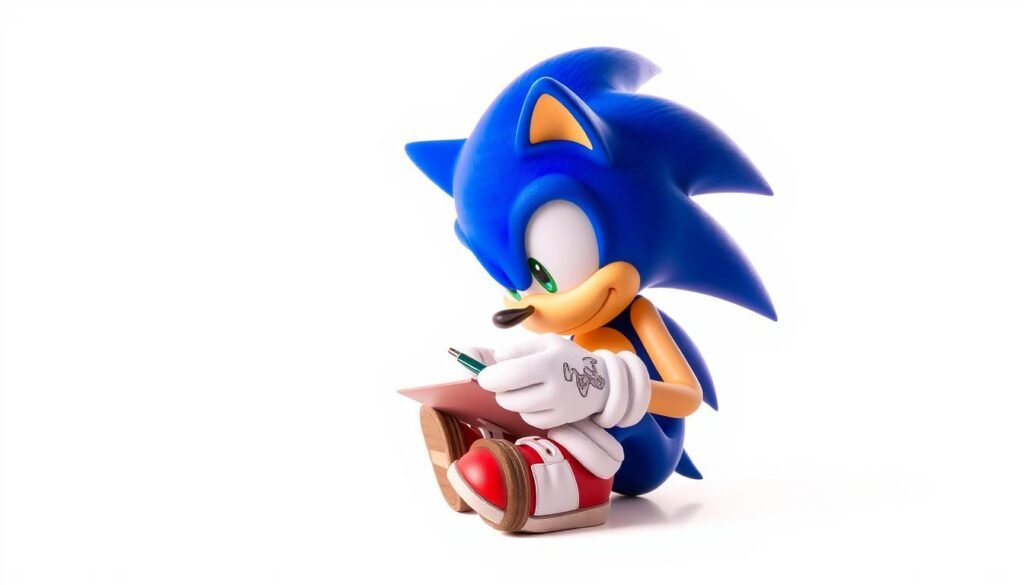Did you know millions of fans worldwide want to learn how to draw their favorite video game characters? Sonic the Hedgehog is one of the most loved characters. Drawing Sonic might seem hard, but it’s easy when you break it down into simple steps.
I’ll show you how to draw Sonic in a simple way. By following these steps, you can make a drawing that looks just like Sonic.
Key Takeaways
- Understand the basic shapes that form Sonic’s character
- Learn to draw Sonic’s iconic features
- Discover how to add color and depth to your drawing
- Practice simple techniques to improve your drawing skills
- Follow a step-by-step guide to drawing Sonic
Introduction to Sonic the Hedgehog
The blue blur, Sonic the Hedgehog, has won the hearts of gamers and artists. He is a cultural icon from video games. Sonic stands for speed, adventure, and a lively spirit that has lasted for years.
Overview of Sonic’s Character
Sonic is famous for his distinctive blue spikes and charismatic personality. He can move at incredible speeds. His adventures have been thrilling fans since the early 1990s.
His character is about courage, friendship, and fighting against evil. His main foe is Dr. Eggman.
Importance of Drawing Sonic
Drawing Sonic is more than just copying his look. It’s about capturing his spirit. For fans, it’s a way to show their love and connect with him. It’s also a chance for artists to get better, as Sonic’s design is simple yet dynamic.
“Art is the only way to run away without leaving home.” – Twyla Tharp
This quote fits the creative act of drawing Sonic. It lets artists dive into their imagination while improving their skills.
What You’ll Need to Get Started
To begin drawing Sonic, you’ll need some basic things:
- Pencils (various hardness levels for shading and detail)
- Eraser (for correcting mistakes)
- Paper (sketch paper or any smooth surface)
- Markers or colored pencils (optional for coloring)
Having these tools ready will make learning how to draw Sonic more fun and helpful.You can read how to draw a horse.
Basic Shapes for Sonic’s Outline
To draw Sonic the Hedgehog right, start with basic shapes. These shapes are the foundation of his outline. Breaking down Sonic’s design into simple shapes helps you draw him more accurately and recognizable.
Starting with Circles
The first step is to draw a circle for Sonic’s head. This circle doesn’t need to be perfect. Sonic’s head is a bit irregular. But, using a circle helps get the proportions right.
![]()
Adding Ovals for the Body
After the head circle, draw an oval for the body. The oval should be bigger than the circle and tilted. This oval is the base for Sonic’s torso and helps place the arms and legs.
Sketching the Head and Face
With the basic shapes done, start refining Sonic’s features. Sketch the face inside the circle, focusing on the eyes, nose, and mouth. Sonic’s eyes are big and expressive, and his mouth is a simple curve.
| Shape | Description | Importance |
|---|---|---|
| Circle | Used for the head | Establishes the head’s proportion and position |
| Oval | Used for the body | Defines the torso and helps in placing limbs |
| Lines and Curves | Used for facial features and details | Brings Sonic to life with expression and character |
By following these steps and focusing on basic shapes, you can lay a solid foundation for your Sonic drawing. Remember, the key to a great drawing is in the proportions and the details that follow.You can read how to draw a tree.
Drawing Sonic’s Face
To capture Sonic’s energetic personality, mastering his face is key. Sonic’s face is simple yet distinctive, making it fun to draw.
Positioning the Eyes
Sonic’s eyes are very expressive. Start by placing two large ovals high on the head. Make sure they’re evenly spaced and close together. The eyes should be big and show Sonic’s adventurous spirit.
Shaping the Mouth
The mouth is vital for Sonic’s face. Draw a small, curved line for a cheerful smile. This smile should be subtle yet clear, showing Sonic’s friendly side.
Adding Expression to Sonic
To make Sonic come alive, add expression to his face. Adjust the eyes and mouth to show his personality. For a more dynamic look, try tilting the eyebrows or changing the smile’s curve. For more tips on drawing Sonic’s face, check out this helpful resource.
| Feature | Description | Tips |
|---|---|---|
| Eyes | Large ovals, high on the head | Ensure they are evenly spaced and expressive |
| Mouth | Small, curved line for a smile | Keep it subtle yet distinctive |
| Expression | Adjust eyes and mouth for personality | Experiment with different adjustments for various expressions |
Sketching Sonic’s Body
The next step in drawing Sonic is to sketch his body. We need to focus on proportions. Let’s break it down into parts we can handle.
Proportions and Anatomy
To draw Sonic right, we must know his proportions and anatomy. He’s a blue anthropomorphic hedgehog with key features. His body is muscular and built for speed.
Make sure Sonic’s torso is about twice as big as his head. His arms and legs should match the body size. The legs should be a bit more muscular to show his jumping power.
| Body Part | Proportion |
|---|---|
| Head | 1 unit |
| Torso | 2 units |
| Arms | 1.5 units |
| Legs | 2 units |
Drawing the Arms and Legs
Sonic’s arms and legs are key to his pose. His arms should be strong but not too big. The legs are important for showing his speed and agility.
For a detailed guide on drawing characters like Sonic, check out this tutorial for more tips.

Creating Sonic’s Spikes
Sonic’s spikes are very distinctive. Start by finding the base of each spike on his head. The spikes should be evenly spaced and vary in size, with the biggest one at the back.
To make Sonic look more dynamic, the spikes should not be perfectly uniform. A bit of variation will make him look more natural and interesting.
Adding Sonic’s Iconic Gloves and Shoes
Sonic’s look isn’t complete without his gloves and shoes. We’ll focus on drawing these in this section. They’re key to capturing his character and spirit.
![]()
Designing the Gloves
Sonic’s gloves are a unique part of his design. Start by sketching the basic shape, which is a mitten style. Pay attention to the details like the white gloves with a gold ring and band at the wrist. These gloves not only look good but also show Sonic’s readiness for action.
How to Draw Sonic’s Signature Shoes
Drawing Sonic’s shoes means capturing their unique design. They have red and white colors and distinct laces. Start by outlining the basic shape, making sure it fits Sonic’s feet well. The shoes should be red with white accents and look sporty and sleek. Adding the laces and ensuring the shoes are the right size will make your drawing more authentic.
For more detailed guidance on drawing Sonic, visit how to draw sonic for more tips and techniques.
Finalizing the Outline
Refining your Sonic sketch means cleaning up lines and checking proportions. You’re aiming for a polished and professional look.
Cleaning Up Your Sketch
Start by erasing any lines you used to draw Sonic’s basic shapes. Focus on the eyes, spikes, and gloves. These features are what make Sonic unique.
Tip: Use a gentle eraser to avoid smudging. If drawing digitally, use ‘undo’ or a layer mask to refine lines without losing your work.
Ensuring Proportions Are Correct
Checking Sonic’s proportions is key. Compare your drawing to reference images or the original Sonic. Make sure the eyes, arms, legs, and spikes are the right size.

As “The key to a great drawing is not just in the initial sketch but in the refinement and attention to detail.” This shows how important it is to focus on details and proportions.
By following these steps, you’ll create a professional Sonic drawing. Remember, practice makes perfect. Don’t get discouraged if it takes a few tries.
Adding Color to Your Sonic Drawing
The final step in drawing Sonic is adding color. This can make your artwork really stand out. With your Sonic sketch done, you can now bring it to life with the right colors.
Choosing the Right Color Palette
To color Sonic right, pick a palette that matches his iconic look. Sonic is mostly blue, with white gloves and shoes, and red shoes laces. You can use colored pencils, markers, or digital tools to get the look you want.
For an authentic look, stick to the original Sonic colors. You can also try different shades to add depth and dimension to your drawing.
![]()
Techniques for Coloring Sonic
Start with the largest areas first, like Sonic’s blue body. Use smooth, even strokes to cover the area. For the gloves and shoes, use white or light gray for a clean contrast.
For detailed work, like the shoes laces, use a finer tip or a smaller brush to add the red details. You can also add shading to give your Sonic drawing more depth.
Tips for Shading and Highlights
Shading is key for adding dimension to your Sonic drawing. Use darker shades of blue for shadows, like under the chin, around the eyes, and on the sides of the body.
Highlights can be added using lighter shades or white. For example, add a highlight on Sonic’s gloves and shoes to make them look more realistic.
| Coloring Technique | Description | Effect |
|---|---|---|
| Smooth Strokes | Use even, smooth strokes for large areas | Uniform color |
| Layering | Layer different colors to achieve depth | Dimension and texture |
| Shading | Use darker shades to create shadows | Depth and realism |
For more guidance on drawing Sonic, visit https://artprojectsforkids.org/how-to-draw-sonic/ for more tips and tutorials.
Common Mistakes to Avoid
Learning to draw Sonic the Hedgehog can be tricky. It’s important to know the mistakes that can make your drawing look off. When you’re learning how to draw Sonic, watch out for these common errors.

Overcomplicating the Design
One big mistake is making Sonic’s design too complicated. It’s easy to add too many details. But, too many details can make your drawing messy.
Stick to the key features that make Sonic easy to recognize. These are his blue spikes, red shoes, and his confident look. Keeping it simple will make your drawing look cleaner and more iconic.
Ignoring Proportions
Another mistake is not paying attention to Sonic’s proportions. Getting the size and placement of his body parts right is key. This makes your drawing look real.You can read how to draw a pumpkin.
Use basic shapes to help you get the proportions right. This will guide you in placing Sonic’s features correctly.
Skipping Basic Shapes
Not using basic shapes when drawing Sonic is a big mistake. Starting with simple shapes like circles and ovals is a good idea. These shapes help you get the foundation of your drawing right.
By avoiding these mistakes, you can improve your Sonic drawings. Remembering these tips will make practicing more fun and help you get better at drawing.
Advanced Techniques for Sonic Drawings
Once you’ve mastered the basics, it’s time to try more advanced methods for drawing Sonic. As you get better at drawing Sonic, you can play with your artwork. This makes it more interesting and lively.

Experimenting with Different Poses
One way to make your Sonic drawings better is to try different poses. Instead of just drawing Sonic standing still, try drawing him in action. This could be when he’s running, jumping, or spinning.
To do this, you can learn how to draw Sonic in various poses. Look at reference images or watch how he moves in the game.
Using Reference Images
Reference images are key when drawing Sonic in different poses or scenes. They help make sure your drawings are accurate and detailed. You can find these images in Sonic games, animated series, or fan art.
By looking at these references, you can learn more about Sonic’s body and how to draw him in different situations.
Incorporating Background Elements
Adding background elements to your Sonic drawings can make them more interesting. This could be the Green Hill Zone or a cityscape. Backgrounds help tell a story and make your drawing more engaging.
Start by sketching simple backgrounds and add more details as you get better. The important thing is to keep Sonic the main focus.
By using these advanced techniques, you can make your Sonic drawings more complex and interesting. Don’t be afraid to try new things. It’s all part of the creative journey.
Conclusion and Next Steps
Now you know how to draw Sonic. It’s time to practice what you’ve learned. Drawing Sonic takes patience and dedication. But with regular practice, you can get better at it.
Practicing Your Skills
Set aside time each day to practice drawing Sonic. Start by following the steps from this article. Then, try drawing Sonic in different poses and expressions.
As you get more confident, draw Sonic in various scenarios. Try him running or jumping.
Further Learning Resources
For more help, check out online tutorials or drawing books. Look for ones on cartoon characters or comic book art. Websites like Proko, New Masters Academy, and Skillshare have lots of drawing tips and character design info.
Sharing Your Creations
When you’re happy with your Sonic drawings, share them. Post your artwork on Instagram or Facebook. Or join online communities for Sonic fans.
Sharing your work lets you connect with other fans. It also helps you get feedback on your drawings.
Keep practicing and learning, and soon you’ll draw Sonic easily and confidently. Happy drawing!





















